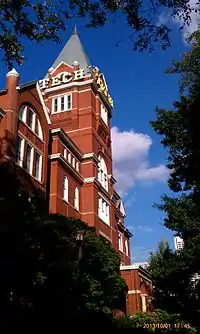Bobby Dodd Stadium
Bobby Dodd Stadium at Historic Grant Field is the football stadium located at the corner of North Avenue at Techwood Drive on the campus of the Georgia Institute of Technology in Atlanta. It has been home to the Georgia Tech Yellow Jackets football team, often referred to as the "Ramblin' Wreck", in rudimentary form since 1905 and as a complete stadium since 1913. The team participates in the NCAA Division I Football Bowl Subdivision as a member of the Atlantic Coast Conference. It is the oldest stadium in the FBS and has been the site of more home wins than any other FBS team.
"The Flats" | |
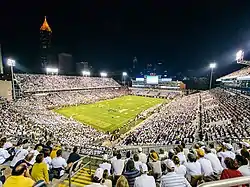 A view of Bobby Dodd Stadium during a night game against Virginia Tech | |
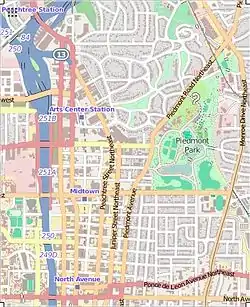 Bobby Dodd Stadium Location in midtown Atlanta 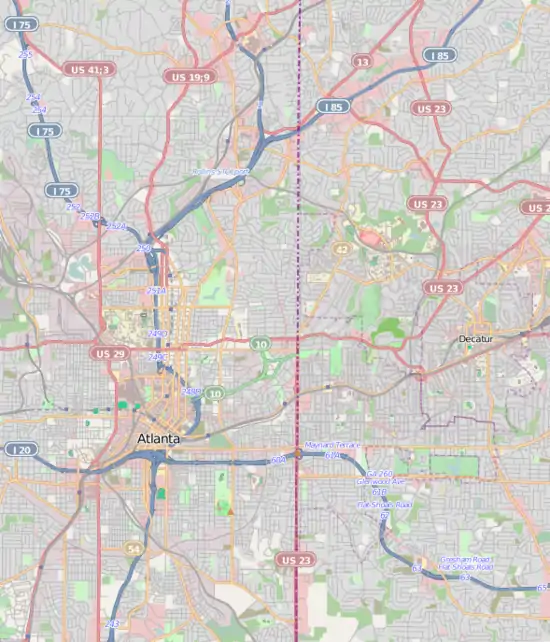 Bobby Dodd Stadium Location in Atlanta 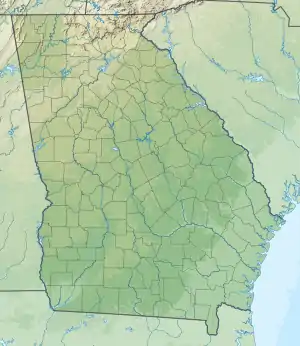 Bobby Dodd Stadium Location in Georgia  Bobby Dodd Stadium Location in the United States | |
| Former names | Grant Field (1913–1988) |
|---|---|
| Address | 155 North Avenue, Northwest |
| Location | Atlanta, Georgia |
| Coordinates | 33°46′21″N 84°23′34″W |
| Owner | Georgia Institute of Technology |
| Operator | Georgia Institute of Technology |
| Capacity | 55,000 (2003–present) 43,719 (1989–2002) 46,000 (1986–1988) 58,121 (1967–1985) 53,300 (1962–1966) 44,000 (1947–1961) 30,000 (1925–1946) 25,000 (1919–1924) 7,000 (1913–1918) |
| Record attendance | 60,316 1973 (vs. Georgia)[1] |
| Surface | Bermuda grass (1913–70, 1995–2019) Astroturf (1971–94) Shaw Legion NXT synthetic turf (2020–present) |
| Construction | |
| Broke ground | April 1913 |
| Opened | September 27, 1913[2] |
| Renovated | 2003 |
| Expanded | 1924, 1925, 1947, 1958, 1962, 1967, 2003 |
| Construction cost | $35,000 (original west stands)[3] ($905 thousand in 2019 dollars[4]) $75 million (Latest expansion) |
| Architect | Charles Wellford Leavitt[5] HOK Sport (renovation) |
| Tenants | |
Georgia Tech Yellow Jackets (NCAA) (1913–present)
Atlanta Beat (WUSA) (2001) Atlanta United FC (MLS) (2017) | |
Location
The stadium is located on the east side of the Georgia Tech campus,[6] across from freshman housing facilities and just a short walk from the campus library and fraternity/sorority row. The facility is in Midtown Atlanta, just off Interstate 75/85 (the "Downtown Connector"), across from the famed Varsity restaurant.
History
Grant Field is the oldest continuously used on-campus site for college football in the Southern United States, and the oldest in the FBS.[7]
Football has been played at the current site since 1905. In 1913, permanent grandstands were built for the first time, mostly by Tech students.[8][9] It was originally named for Hugh Inman Grant, son of John W. Grant, a well-known Atlanta merchant and original benefactor of the stadium. From 1913 to 1919, the stadium grew from a capacity of 7,000 to one of 25,000.[10]

The stadium bears little, if any, resemblance to its original form, having been expanded many times. The original facility, roughly corresponding to the lower level of the current stadium's west grandstands, seated 5,600. The terrain in the area slopes upward from north to south, a slope very noticeable in the background of early photos, before the slopes were covered by the large stands built over them. Due to that natural grade, much of the field itself is below street level. The houses observable in the background of early photos were replaced by dormitory buildings in the 1930s.
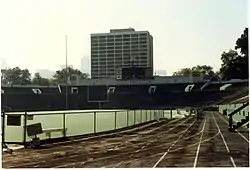
By 1925, the east and south stands were completed, making the stadium a 30,000-seat horseshoe with an open north end. The west stands were rebuilt and a large press box was added in 1947, bringing capacity up to 44,000. The original all-steel 4,105-seat North stands were erected in 1958, and in 1962 and 1968 the upper decks were added to the East and West sides, respectively, bringing capacity to its all-time high of 58,121. Following this, Grant Field hosted the inaugural Peach Bowl in 1968, and would serve as its venue from 1968 to 1970.[11] Grant Field also served as the home field for the Atlanta Apollos of the North American Soccer League for their 1973 season.[12] In August 1984, the stadium hosted the annual Drum Corps International World Championships. In 1985 the South stands were razed to make room for the William C. Wardlaw Center, a modern field house and athletic office facility to replace the facilities in the old Heisman Gym, which was located just to the north of the stadium; the construction of the Wardlaw Center reduced the stadium's capacity to 46,000.
In 1988, the stadium was renamed in honor of Bobby Dodd,[13] who has the most wins of any coach in the team's history. The playing surface is still named Grant Field.
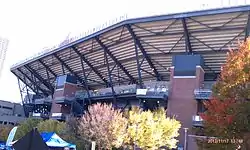
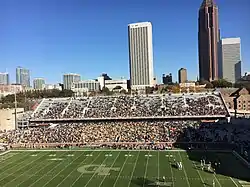
l space is currently used for storage.[14] Grant Field was occasionally used as a site for Atlanta Falcons games during the team's early years when it was sharing Fulton County Stadium with the Atlanta Braves of Major League Baseball and there were scheduling conflicts.[15] The lighting was replaced in 1998.[16]
In 2001, the stadium served as the home venue for the Atlanta Beat of the Women's United Soccer Association in their inaugural season.[12] Following the 2001 season, a major expansion and renovation project was started, which was done in two phases in order to play the 2002 season in the stadium. For the 2002 season, seating was returned to the South end in front of the Wardlaw Center, and the original North stands and lower east bleachers were rebuilt and bowled in. After the 2002 season, the expansion was completed by adding a massive free standing upper deck in the north end zone. This addition of a north end zone upper deck brought Bobby Dodd Stadium to its current capacity. The new stadium was rededicated during the 2003 home season opener versus the Auburn Tigers on September 2, 2003.
In the summer of 2009, Bobby Dodd Stadium underwent a number of changes. First, the scoreboard was renovated and after completion, is now twice as big as the old scoreboard. Also, ribbon boards were installed in front of the Wardlaw Center, as well as along the sides of the stadium. Another change was the improvement of the sound system in the stadium.[17]
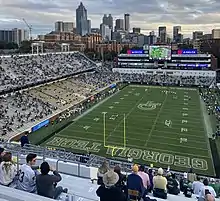
On October 5, 2016, Major League Soccer expansion team Atlanta United FC announced that it would play its home matches for the first half of the 2017 MLS season at Bobby Dodd Stadium until Mercedes-Benz Stadium was ready in mid-2017.[18] The soccer club paid the university and the athletic association over $1 million for the usage of Bobby Dodd Stadium.[19]
On June 9, 2020, Georgia Tech athletics officials announced that the playing surface of Bobby Dodd Stadium would be replaced with the Legion NXT synthetic turf by Shaw Sports.[20]
Notable games
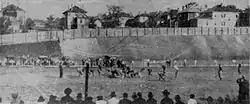
October 7, 1916: Georgia Tech 222, Cumberland College 0
In the most lopsided game in American football history, Georgia Tech, under coach John Heisman, defeated Cumberland College, 222–0. It has been said that Coach Heisman was repaying the Bulldogs for a 22–0 baseball defeat the previous year in which Cumberland had allegedly used professional players to ensure victory or conversely that he was showing how that running up the score against weak opponents was vastly influential over the voters in college football rating polls.[21] In any case, the Engineers (as the Georgia Tech team was known at the time) never threw a pass and never took more than four plays to score.
[22]
November 29, 1917: Georgia Tech 68, Auburn 7
This win marked the end of the first undefeated, untied National Championship season for the Yellow Jackets. In 1917, Georgia Tech outscored opponents 491–17 in the midst of a 33-game undefeated streak spanning over five seasons.[23][24]
December 8, 1928: Georgia Tech 20, Georgia 6
This was the culmination of Georgia Tech's second perfect season and National Championship, though the Yellow Jackets would go on to the Rose Bowl to face Cal in what would turn out to be a famous game itself. Georgia Tech played only two away games in its 9-0 regular season lineup hosting Notre Dame, Alabama, Auburn and Georgia. The main reason for this is that many of the other Southern teams' stadiums were not as large or accessible as Grant Field in Midtown Atlanta.[25]
| External image | |
|---|---|
November 15, 1952: #4 Georgia Tech 7, #12 Alabama 3
In one of the biggest games of Georgia Tech's third National Championship season, two of the highest ranked teams to ever face off on Grant Field saw Georgia Tech defeat Alabama in a closely matched defensive battle. Georgia Tech's Jake "Mouse" Rudolph was knocked unconscious by tackling Alabama's Bobby Marlow on a fourth-down play on the goal line late in the game, which became known as the "$125,000 tackle". This play prevented Alabama from scoring and provided the Yellow Jackets with the opportunity to win the game with one touch down drive. The victory preserved the Yellow Jackets' undefeated record, and Georgia Tech was invited to play in the Sugar Bowl and earned the bowl payout. Tech, which had already defeated number 6 Duke would go on to defeat Florida State, Georgia and undefeated number 7 Mississippi (in the Sugar Bowl) in the midst of a 31-game undefeated streak.[26][27][28]
November 17, 1962: Georgia Tech 7, #1 Alabama 6
This upset victory over top-ranked Alabama ended the Crimson Tide's 26-game unbeaten streak. Bobby Dodd called it his greatest victory as Tech thwarted Alabama comeback efforts by preventing a two-point conversion attempt and intercepting a Joe Namath pass deep in their own territory with just 1:05 left.[29]
October 5, 1969: Baltimore Colts 21, Atlanta Falcons 14
This was the only regular season NFL game played at Grant Stadium. The stadium hosted this game because the Atlanta Braves were playing in the National League Championship Series against the New York Mets.
November 6, 1976: Georgia Tech 23, #11 Notre Dame 14
In the most memorable game of a 4-6-1 season, Georgia Tech defeated #11 Notre Dame without throwing a forward pass.[30] After quarterback Gary Lanier was sacked while dropping back to pass in the first quarter, Notre Dame's Ross Browner and Willie Fry celebrated on the field. Georgia Tech coach Pepper Rodgers decided to not allow the Fighting Irish the chance to strut after a sack, and called for a run on every subsequent play. The unusual strategy worked, and the Yellow Jackets upset Notre Dame.
October 13, 1990: #15 Georgia Tech 21, #14 Clemson 19
Only two seasons removed from a 3-8 1988 season, Coach Bobby Ross had led his team to a 4-0 record to face the Tigers. The Yellow Jackets came out on top of this closely matched battle and would go on to defeat number 1 Virginia and number 19 Nebraska in the Citrus Bowl for its fourth National Championship.[31]
October 17, 1998: #25 Georgia Tech 41, #7 Virginia 38
In the second meeting between two highly ranked Georgia Tech and Virginia teams (the first being in 1990), Georgia Tech again came out victorious by the same score of 41–38, earning the Yellow Jackets a share of the ACC Championship. Virginia jumped to a big lead in this Georgia Tech homecoming game. Big plays by GT finally put them ahead late in the game, including a dramatic touchdown pass by Joe Hamilton to Dez White. Virginia missed a field goal in the final seconds prompting thousands of Georgia Tech fans to pour onto the field.[32]
November 27, 1999: #16 Georgia Tech 51, #21 Georgia 48 (OT)
In the highest scoring game ever in the series, Georgia overcame a 17-point deficit in the second half to tie the game and appeared to be within easy victory after driving all the way to Tech's 2-yard line with nine seconds left in regulation. Rather than kick a game-winning field goal, Georgia coach Jim Donnan called a running play that was ruled a fumble by Jasper Sanks which Georgia Tech recovered in the endzone. Replays seemed to indicate that the runner was down when the ball came out, anyway Georgia lost. In overtime, after intercepting a Georgia pass in the endzone, Tech attempted a field goal on third down in its possession. The kick was blocked, but Tech holder George Godsey recovered the ball. Tech kicker Luke Manget's second chance at the kick was good. The Georgia Tech student section rushed the field and tore down the goal posts. As of 2019, this remains Georgia Tech's most recent home win over Georgia.
November 1, 2008: Georgia Tech 31, #16 Florida State 28
Prior to the November 1 meeting between FSU and Georgia Tech, Bobby Bowden was undefeated against Georgia Tech. Florida State Coach Bobby Bowden had never lost to Georgia Tech in 12 meetings. The last time Georgia Tech defeated Florida State in football was in 1975. During Paul Johnson's first year as head coach, Georgia Tech had a 6-2 record going into the game. Georgia Tech fell behind by a touchdown twice in the first quarter, but pulled ahead in the 2nd quarter to finish the first half leading 24-20. A third-quarter touchdown put Tech up 31-20, but Florida State rallied, scoring a touchdown and converting on the two-point attempt to come within three points. On their final drive Florida State drove down to inside the five-yard line. Florida State running back Marcus Sims received the handoff and was headed for the end zone, but was met by Georgia Tech freshman, Cooper Taylor, son of former Tech QB Jim Bob Taylor. The football was knocked loose into the end zone and recovered by Tech freshman Rashaad Reid to secure the victory for the Jackets. Fans swarmed the field after witnessing their team snap a 12-game losing streak to the Seminoles, Tech's longest to any modern team.[33]
October 17, 2009: #19 Georgia Tech 28, #4 Virginia Tech 23
Played before an emotionally charged crowd, this was the first time Georgia Tech defeated a top-5 team at home since beating No. 1 Alabama 7-6 in 1962. After the victory students rushed the field, tore down the goalpost at the north end zone, and carried it to Georgia Tech President George P. "Bud" Peterson's house. The victory launched the Jackets to #11 in the AP Poll. This was the pivotal game which helped Georgia Tech win the ACC Coastal Division title. Later, the Jackets beat Clemson in the 2009 ACC Championship Game and earned its first conference title since 1998 and its first Orange Bowl berth since 1967.[34] However this victory and the title were later vacated.[35][36]
October 29, 2011: Georgia Tech 31, #5 Clemson 17
Before a sellout crowd of 55,646, Georgia Tech rebounded from two consecutive losses to upset #5 Clemson. The Tigers, who were undefeated before the game, turned the ball over 4 times in the game and allowed Georgia Tech to rush for 383 yards. Tevin Washington led the Yellow Jackets by rushing for 176 yards on 27 carries and a touchdown, which was the most rushing yards ever by a Georgia Tech quarterback. The Yellow Jackets raced to a 24-3 halftime lead and held off Clemson, which was 8-0 for the first time since 2000, when Georgia Tech defeated the then #4 Clemson Tigers. It was Tech's first win against a top-5 team since defeating #4 Virginia Tech in 2009.[37]
October 24, 2015: Georgia Tech 22, #9 Florida State 16
Before a sellout crowd of 55,000, Georgia Tech rebounded from five consecutive losses to opponents with combined records of 30-4 to upset #9 Florida State University, a program that had won 28 consecutive conference games, the 2013 Vizio BCS National Championship, and two consecutive Atlantic Coast Conference Titles. Over their last 51 games, Florida State was 48-3. The Seminoles, who were undefeated before the game, had the ball with 3rd and goal to go with eight minutes remaining, up 16-13, when Everett Golson's intended pass was deflected off Georgia Tech cornerback Lawrence Austin's shoe and intercepted by veteran senior safety Jamal Golden. Harrison Butker of the Yellow Jackets nailed a 25-yard field goal with 57 seconds remaining to tie the game at 16. Florida State drove down the field, and set itself up for a 56-yard game-winning field goal by Roberto Aquayo, who was 26 for 26 all time on field goal attempts in the fourth quarter, and 63 for 63 on extra points in the fourth quarter. The potential game-winning kick was blocked by Patrick Gamble of the Yellow Jackets, and recovered by Lance Austin at the 22 yard line, where he dazzled his way amongst a convoy of Georgia Tech blockers 78 yards down the gridiron into the endzone as time expired, giving Georgia Tech its third win of the 2015 season, and third Top 10 win under Paul Johnson's guidance. Daniel Palka was in attendance.
Capacity
| Period | Capacity |
|---|---|
| 1913–23 | 5,304 |
| 1924 | 18,000 |
| 1947–57 | 40,000 |
| 1962–66 | 53,300 |
| 1967–87 | 58,121 |
| 1988–2000 | 46,000 |
| 2001 | 41,000 |
| 2002 | 43,719 |
| 2003–present | 55,000 |
References
- Sohani, Alex (August 18, 2011). "Athletic Venues Embody Tech's Winning Background". The Technique. Georgia Institute of Technology. Retrieved August 18, 2011.
- 1913 Georgia Tech football schedule
- Sugiura, Ken (September 26, 2013). "Notes: Scheduling, Grant Field History and More". The Atlanta Journal-Constitution. Retrieved November 6, 2013.
- Federal Reserve Bank of Minneapolis. "Consumer Price Index (estimate) 1800–". Retrieved January 1, 2020.
- Funderburke, Dick. "Historic Grant Field". Hometown Atlanta. Archived from the original on September 27, 2016. Retrieved November 6, 2013.
- "Campus Map: Bobby Dodd Stadium". Georgia Institute of Technology. Archived from the original on July 4, 2013. Retrieved March 24, 2007.
- "Bobby Dodd Stadium At Historic Grant Field: A Cornerstone of College Football for Nearly a Century". Georgia Tech Athletic Association. Archived from the original on April 16, 2007. Retrieved March 24, 2007.
- Edwards, Pat (October 15, 1999). "Students build first stands at Grant Field". The Technique. Georgia Institute of Technology. Archived from the original on January 22, 2008. Retrieved April 10, 2007.
- "Tech Timeline: 1910s". Georgia Tech Alumni Association. Archived from the original on October 16, 2007. Retrieved March 24, 2007.
- Fuzzy Woodruff. A History of Southern Football. 2. p. 80.
- "History". Chick-fil-A Peach Bowl. August 12, 2015. Retrieved December 15, 2018.
- Newberry, Paul (March 3, 2017). "Atlanta debuts in MLS at stadium known for college football". The Washington Times. Retrieved November 21, 2019.
- Edwards, Pat (October 1, 1999). "Football Program, Traditions Spurred by Dodd". The Technique. Georgia Institute of Technology. Archived from the original on February 8, 2007. Retrieved April 10, 2007.
- Adelson, Andrea (September 4, 2015). "Seven more odd things you never knew about college football stadiums". ESPN.com. Retrieved September 4, 2015.
- "Baltimore Colts at Atlanta Falcons - October 5th, 1969". Pro-Football-Reference. Copyright © 2000-2020 Sports Reference LLC. Retrieved May 4, 2020.
- Samon, Jon (February 6, 1998). "Let There Be Light at Bobby Dodd Stadium". The Technique. Georgia Institute of Technology. Archived from the original on January 9, 2008. Retrieved May 18, 2007.
- Hartstein, Larry (April 18, 2009). "Jackets' Kicking Game Remains a Concern". The Atlanta Journal-Constitution. Retrieved May 8, 2009.
- Roberson, Doug. "Atlanta United will play first home games at Georgia Tech". The Atlanta Journal Constitution. Retrieved October 5, 2016.
- Sugiura, Ken. "7 things to know about Atlanta United at Bobby Dodd Stadium". The Atlanta Journal-Constitution. Retrieved June 19, 2018.
- "Georgia Tech to install artificial turf at Bobby Dodd Stadium". Georgia Tech Athletics. June 9, 2020. Retrieved June 29, 2020.
- Jon Bois (October 7, 2016), 222-0. PRETTY GOOD, EPISODE 10., retrieved October 1, 2018
- "Georgia Tech Football". Georgia Encyclopedia. Retrieved December 22, 2012.
- "Georgia Tech Yellow Jackets 1917 Season Schedule". Database Football. Archived from the original on June 2, 2013. Retrieved December 22, 2012.
- "1917 College Football National Championship". Tip Top 25. Archived from the original on July 8, 2013. Retrieved December 22, 2012.
- "Georgia Tech Yellow Jackets 1928 Season Schedule". Database Football. Archived from the original on June 2, 2013. Retrieved December 21, 2012.
- Van Brimmer, Adam; Rice, Homer (October 2011). 100 Things Yellow Jackets Fans Should Know & Do Before They Die. Chicago: Triumph Books. ISBN 9781617495748. Retrieved December 21, 2012.
- "Georgia Tech to Honor Former Yellow Jackets Teams". WRDW. Augusta, Georgia. August 20, 2012. Archived from the original on February 9, 2013. Retrieved December 21, 2012.
- Van Brimmer, Adam (September 1, 2006). Stadium Stories: Georgia Tech Yellow Jackets. Globe Pequot. ISBN 9780762740208. Retrieved December 21, 2012.
- Sharnik, Morton; Creamer, Robert (November 26, 1962). "A Rough Day for the Bear". Sports Illustrated. Retrieved December 21, 2012.
- "Beat Notre Dame Without Throwing a Pass? Georgia Tech Did It in 1976". Georgia Tech Athletic Association. Associated Press. August 25, 2006. Retrieved November 6, 2013.
- George, Thomas (October 14, 1990). "Ga. Tech Outlasts Clemson". The New York Times. Retrieved December 21, 2012.
- "GT's Magnificent Seven". Georgia Tech Athletic Association. June 13, 2008. Retrieved December 21, 2012.
- "Florida State Seminoles vs. Georgia Tech Yellow Jackets – Recap". ESPN. Associated Press. November 1, 2008. Retrieved December 20, 2012.
- "Virginia Tech Hokies vs. Georgia Tech Yellow Jackets – Recap". ESPN. October 17, 2009. Retrieved December 20, 2012.
- "NCAA places Georgia Tech on probation". ESPN. Associated Press. July 14, 2011. Retrieved July 14, 2011.
- Sugiura, Ken (November 12, 2011). "Georgia Tech's Appeals Hearing Sunday". The Atlanta Journal-Constitution. Retrieved April 13, 2013.
- "Tevin Washington Runs for 176 Yards as Georgia Tech Knocks off Clemson". ESPN. Associated Press. October 29, 2011. Retrieved December 5, 2012.
External links
| Wikimedia Commons has media related to Bobby Dodd Stadium. |
- Georgia Tech Bobby Dodd stadium official website
- Bobby Dodd Stadium on Google Maps
| Events and tenants | ||
|---|---|---|
| Preceded by first stadium |
Home of the Peach Bowl 1968–1970 |
Succeeded by Atlanta–Fulton County Stadium |
| Preceded by Miami Orange Bowl |
Host of the Drum Corps International World Championship 1984 |
Succeeded by Camp Randall Stadium |
| Preceded by Francis Field |
Host of the College Cup 1968 |
Succeeded by Spartan Stadium |
| Preceded by first stadium |
Home of Atlanta United FC 2017 |
Succeeded by Mercedes-Benz Stadium |
